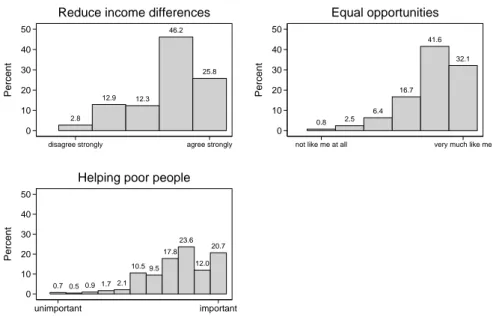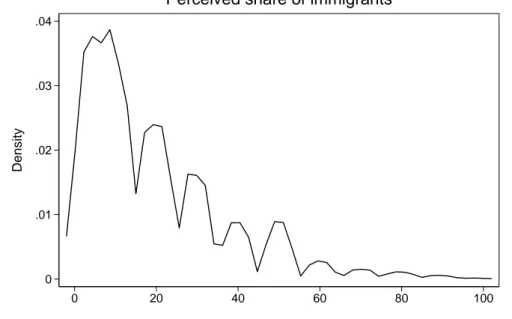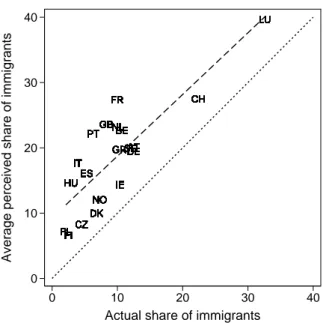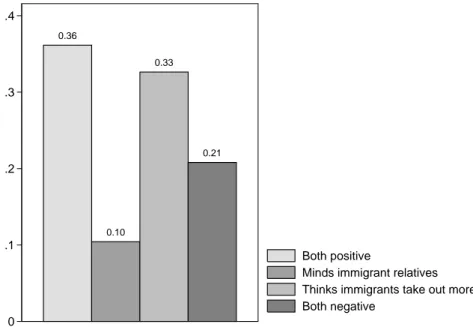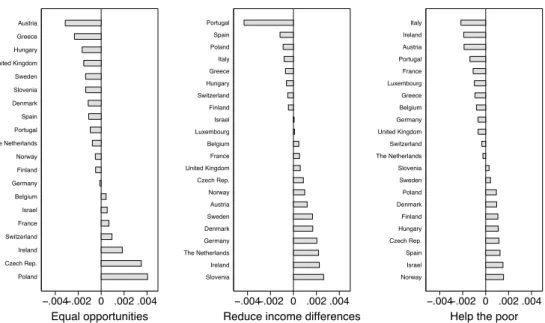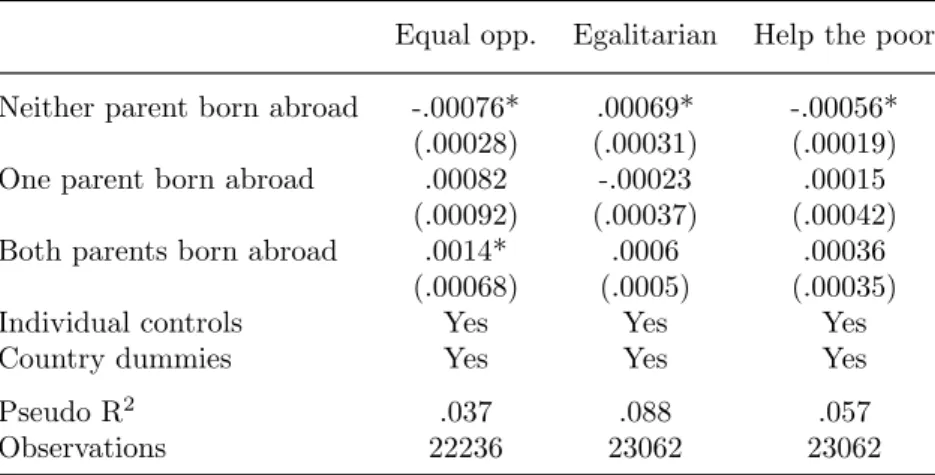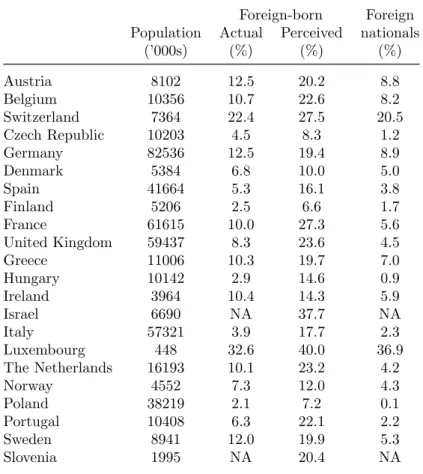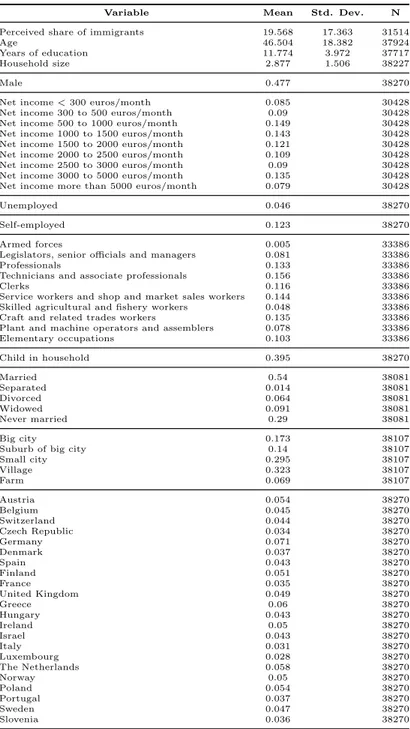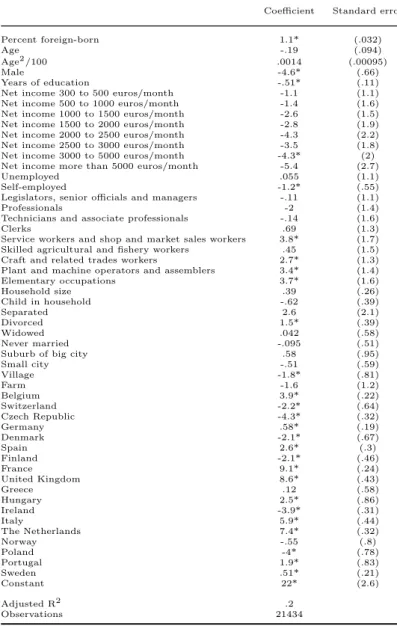HAL Id: halshs-00586256
https://halshs.archives-ouvertes.fr/halshs-00586256
Preprint submitted on 15 Apr 2011
HAL is a multi-disciplinary open access
archive for the deposit and dissemination of
sci-entific research documents, whether they are
pub-lished or not. The documents may come from
teaching and research institutions in France or
abroad, or from public or private research centers.
L’archive ouverte pluridisciplinaire HAL, est
destinée au dépôt et à la diffusion de documents
scientifiques de niveau recherche, publiés ou non,
émanant des établissements d’enseignement et de
recherche français ou étrangers, des laboratoires
publics ou privés.
Immigration and natives’ attitudes towards the welfare
state: Evidence from the European Social Survey
Claudia Senik, Holger Stichnoth, Karine van der Straeten
To cite this version:
Claudia Senik, Holger Stichnoth, Karine van der Straeten. Immigration and natives’ attitudes towards
the welfare state: Evidence from the European Social Survey. 2008. �halshs-00586256�
WORKING PAPER N° 2008 - 43
Immigration and natives' attitudes towards the welfare state:
Evidence from the European Social Survey
Claudia Senik
Holger Stichnoth
Karine Van der Straeten
JEL Codes: D31, D64, I3, Z13
Keywords: welfare state, immigration, income
redistribution, reciprocity, European Social Survey
P
ARIS
-
JOURDAN
S
CIENCES
E
CONOMIQUES
L
ABORATOIRE D
’E
CONOMIE
A
PPLIQUÉE
-
INRA
48,BD JOURDAN –E.N.S.–75014PARISTÉL. :33(0)143136300 – FAX :33(0)143136310
Immigration and Natives’ Attitudes towards
the Welfare State: Evidence from the European
Social Survey
Claudia Senik
Paris School of Economics, University Paris IV, IZA Bonn, and IUF
Holger Stichnoth
∗
Paris School of Economics
Karine Van der Straeten
Paris School of Economics and ´
Ecole Polytechnique
June 24, 2008
∗
Corresponding author. Address: Paris School of Economics, 48 boulevard Jourdan,
75014 Paris, France. E-Mail: stichnoth@pse.ens.fr. We thank participants of the
An-nual Conference of the American Economic Association (Chicago, January 2007) for useful
comments, and gratefully acknowledge financial support from CEPREMAP, the German
Academic Exchange Service (DAAD), and MIRE-DREES. All errors are ours.
Abstract
Does immigration reduce natives’ support for the welfare state?
Ev-idence from the European Social Survey (2002/2003) suggests a more
qualified relation. For Europe as a whole, there is only weak evidence
of a negative association between the perceived presence of immigrants
and natives’ support for the welfare state. However, this weak average
relationship masks considerable heterogeneity across countries.
We distinguish two channels through which immigration could affect
natives’ support for the welfare state: a pure dislike of immigrants and
concerns about the economic consequences of immigration. We find that
natives who hold both negative views react much more negatively to a
given perceived share of immigrants than natives who hold neither view.
However, there is no clear pattern concerning the relative importance
of the two channels.
Finally, we find that natives who hold either of these negative views
of immigrants tend to be less supportive of the welfare state
indepen-dently of the perceived presence of immigrants.
Keywords: welfare state, immigration, income redistribution, reciprocity,
Eu-ropean Social Survey
1
Introduction
Countries differ widely in many aspects of government spending and tax
pol-icy, in particular in their policies regarding redistribution and the welfare state.
Among the possible explanations for these differences, some emphasis has been
put lately on ethnic, cultural, or linguistic fractionalization as a deterrent to
redistributive policies. A number of empirical studies have explored this link
between ethnic fractionalization and redistribution.
1
For example, Alesina and
Glaeser (2004) show that countries with greater ethnic diversity have
signif-icantly lower levels of redistribution as a share of GDP; they estimate that
“about 50 percent of the gap between the United States and Europe may be
due to racial fractionalization” (p. 134).
Over the last four decades, Europe has experienced large-scale immigration,
often from countries with cultural, religious, or ethnic backgrounds that are
quite different from those of the native population. Alesina and Glaeser (2004,
11) argue that this inflow will affect the European welfare state: “one natural
implication of our conclusion that fractionalization reduces redistribution is
that if Europe becomes more heterogeneous due to immigration, ethnic
divi-sions will be used to challenge the generous welfare state.”
We use survey data for 22 European countries from the 2002/2003 round of
the European Social Survey to investigate the link between immigration and
support for the welfare state. We want to find out (1) how the perceived
presence of immigrants is related to natives’ support for the welfare state, and
how this relationship varies (2) with natives’ attitudes towards immigrants and
(3) across countries. The specificity of the present study lies in its emphasis
on parameter heterogeneity and in the use of European instead of U.S. or
Canadian data.
Our main result is that, for Europe as a whole, the association between the
perceived presence of immigrants and natives’ support for the welfare state
is weak at best. We do find some evidence that natives who perceive the
share of immigrants in the population to be high tend to be less supportive of
the welfare state. But the association is very weak and not even statistically
significant for two of our three dependent variables. To give an idea of the
magnitude, an increase in the perceived share of immigrants of one standard
1
See the surveys by Alesina and La Ferrara (2005) and by Stichnoth and Van der Straeten
deviation (about 16 percentage points) is associated with a decrease in the
probability of supporting the welfare state of about one percentage point.
This is small compared to the associations we find for other covariates such as
income or education.
However, although we find only weak evidence for a negative association
be-tween immigration and natives’ support for the welfare state in general, it may
well be that a negative association does exist for certain sub-groups of natives.
In a second step we therefore interact the variables measuring the actual or
perceived presence of immigrants with variables measuring natives’ attitudes
towards immigrants. Exploring this parameter heterogeneity is made possible
by the rich set of such attitudinal variables in the European Social Survey.
We classify these variables into two categories to capture two broad channels
through which attitudes towards immigrants may be related to the support
for the welfare state. The first channel is one of pure taste or “differential
altruism.” If natives feel less close to immigrants than to other natives (or
even actively dislike immigrants), they may be less willing to help them through
redistribution and the welfare state. Whereas this first channel is about what
immigrants are (at least in the perception of natives), the second channel is
about what they do (again as perceived by natives). In particular, we are
interested in how natives view the economic role of immigrants in general and
their contribution to the welfare state in particular. We suspect that natives
who believe that immigrants take undue advantage of the welfare state will
react differently to a given share of immigrants in the population.
2
That
such considerations of fairness affect people’s support for redistribution has
been amply demonstrated in the literature; for example, Fong et al. (2006)
state that in general “people are willing to help the poor, but they withdraw
support when they perceive that the poor may cheat or fail to cooperate by
not trying hard enough to be self-sufficient and morally upstanding” (p. 3).
As expected, we find that the association between the perceived share of
im-migrants and support for the welfare state is most negative for natives who
both dislike immigrants and express concern about the economic consequences
of immigration. By contrast, the association is positive for those natives who
2
In the experimental studies on the effects of ethnic diversity on trust and
trustworthi-ness, these two channels are referred to as preference-based and statistical discrimination;
see Glaeser et al. (2000), Fershtman and Gneezy (2001), Bouckaert and Dhaene (2004),
Habyarimana et al. (2006), Haile et al. (2006), Bornhorst et al. (2006), Falk and Zehnder
(2007).
view immigration positively along both dimensions. There is no clear evidence
concerning the relative importance of the two channels: often, the parameter
estimates for the two intermediate types are not significantly different from
another.
When we include the two channels also as main effects (instead of interacting
them with the perceived share of immigrants), we find that attitudes towards
immigration and attitudes towards the welfare state are strongly associated,
but that this association is little affected by the (perceived) presence of
immi-grants.
A third contribution of our paper is to look at differences across countries
within Europe. We find that the small average effect masks considerable
het-erogeneity across countries.
However, the general result is preserved: the
practical significance of the association between the perceived presence of
im-migrants and natives’ support for the welfare state is small even in the countries
for which the estimated coefficients are largest.
The rest of this paper is organized as follows. In section 2 we briefly review
previous evidence. Then, in section 3, we set up a model to illustrate how the
share of immigrants and the two channels of altruism and economic
considera-tions may interact to influence natives’ demand for redistribution. In secconsidera-tions
4 and 5 we present the data and discuss the specification. Section 6 presents
the main results as well as a number of robustness checks. Section 7 concludes.
2
Previous studies
As noted in the introduction, most studies on the effects of immigration and
ethnic diversity on attitudes towards the welfare state use data from the U.S.,
most often from the General Social Survey.
A first finding from these studies is that in the U.S., the support for the welfare
state differs by “race.” Alesina et al. (2001), Luttmer (2001), and Lind (2007)
all find that blacks tend to be much more supportive of welfare spending than
whites, even controlling for a number of observable characteristics. A recent
article by Keely and Tan (2008) uses classification and regression trees to detect
homogenous subgroups with respect to attitudes towards welfare spending and
income redistribution. Applying these techniques on data from the General
Social Survey for the period 1978–2000, Keely and Tan confirm that the race
of the respondent is important for classifying people with respect to attitudes
towards the welfare state.
Second, in the U.S. attitudes towards blacks are an important predictor of
attitudes towards the welfare state. Using data from the 1986 National
Elec-tion Study, the 1994 General Social Survey, and the 1991 NaElec-tional Race and
Politics Study, Gilens (1995, 1996, 1999) shows that racial stereotypes are
im-portant predictors of the support for welfare spending among white Americans.
Also using data from the General Social Survey, Alesina et al. (2001) confirm
Gilens’ findings that racial attitudes are correlated with support for welfare
spending: whites who believe that blacks are lazy tend to be less supportive
of welfare spending, and whites who have had a black person over for dinner
tend to be more supportive. Lind (2007) also shows evidence from the General
Social Survey. For the period 1972–2002, he confirms that white respondents
who do not mind having or actually have had an African-American at home
tend to be more supportive of welfare spending. For the shorter time span
from 1996 to 2002, Lind shows that blacks who feel closer to blacks tend to be
more supportive, and blacks who feel closer to whites less supportive of welfare
spending. For whites the interaction terms have the expected (opposite) signs,
but are insignificant.
The picture is less clear concerning the relationship between the regional
popu-lation share of Blacks and the support for the welfare state. On the one hand,
Luttmer (2001) shows— using data from the General Social Survey for the
years 1972 to 1993—that in the U.S. people are more likely to express support
for welfare spending if they live in a neighborhood where the share of people
of their own race among welfare recipients is high. This is true whatever the
economic situation of the respondents, even among wealthy people who have
only a very small risk of being welfare recipients themselves. On the other
hand, Alesina et al. (2001), who also use data from the General Social
Sur-vey, find that support among whites is not significantly associated with the
share of blacks in the population of the respondent’s state. This difference
with Luttmer’s results may be due to the fact that Luttmer looks at shares of
blacks among welfare recipients and not in the population as a whole.
More-over, Soroka et al. (2004) find for Canada that “the link [between regional
ethnic diversity and support for social programs] is weak at best” (p. 50);
“moving from 100% majority to 50% majority leads to a decrease in aggregate
support for unemployment and welfare of about .0025%” (p. 51).
3
Model
We assume that individuals’ preferences for redistribution derive from
con-siderations involving their own post-tax income, the average post-tax income
of natives in the economy (denoted by c
N
), and the average post-tax income
of immigrants in the economy (denoted by c
I
). More specifically, individuals
evaluate the redistribution policy by computing the following weighted sum:
c + α
N
p
N
c
N
+ α
I
p
I
c
I
where p
N
(respectively p
I
) is the proportion of natives (respectively
immi-grants) in the economy, α
N
(respectively α
I
) is the weight given to natives’
per capita post-tax income (respectively immigrants’ post-tax income), with
the assumption that αN
≥ αI
.
In our model, redistribution takes the very simple form of a basic income,
which is financed through a tax that is proportional to (exogenous) income.
b = b(t) = tw,
where b is the basic income and w is the average pre-tax income in the economy.
With these assumptions, we can derive an individual’s indirect preferences for
the tax rate t:
V
= tw + (1 − t)w + α
N
p
N
[tw + (1 − t)w
N
] + α
I
p
I
[tw + (1 − t)w
I
]
= w + α
N
p
N
w
N
+ α
I
p
I
w
I
+ t [(w − w) + α
N
p
N
(w − w
N
) + α
I
p
I
(w − w
I
)]
where wN
(respectively wI
) is natives’ pre-tax income (respectively immigrants’
pre-tax income). Since
w = pN
wN
+ pIwI
,
w − w
N
= p
I
(w
I
− w
N
)
the indirect utility from taxation can be written as
V
= [w + α
N
p
N
w
N
+ α
I
p
I
w
I
]
+t [(w − w) − pI(1 − pI) (αN
− αI
) (wN
− wI)]
We assume that all individuals correctly perceive the average income in the
economy, w, but that they have different perceptions regarding pI
and (wN
− wI)
(we only require that these perceptions about natives’ income, immigrants’
in-come and the share of immigrants satisfy the equality w = p
N
w
N
+ p
I
w
I
).
We conclude from this expression that the propensity to favor redistribution
decreases with the individual’s pre-tax income, w, and with the expression
p
I
(1 − p
I
) (α
N
− α
I
) (w
N
− w
I
) .
Since
∂V
∂t∂pI
= −(1 − 2p
I
) (α
N
− α
I
) (w
N
− w
I
) , and p
I
< 1/2
the propensity to favor redistribution depends on the interaction of two
vari-ables: whether the individual likes immigrants or not (through the α
N
− α
I
term) and whether he thinks that immigrants are poorer than natives (through
the w
N
−w
I
term). The model predicts that the sign of the variable “perceived
share of immigrants” is ambiguous: it depends on the perception of the relative
income of immigrants versus natives. If an individual believes that immigrants
are poorer than natives, his demand for redistribution should decrease with his
perception of the number of immigrants in the country. And the effect, always
negative, should be larger in absolute value the more he dislikes immigrants
(α
N
− α
I
large). On the other hand, if an individual believes that immigrants
are richer than natives, his demand for redistribution should increase with his
perception of the number of immigrants in the country. And the effect, always
positive, should be larger the more he dislikes immigrants (α
N
− α
I
large).
Note that in the limit case where the individual makes no difference between
the consumption of natives and immigrants in his utility function (αN
= αI),
his preferences for redistribution should not depend on his perception of the
share of immigrants in the economy.
4
Data
4.1
The dataset
We use about 23000 observations for 22 countries from the first round of the
European Social Survey (ESS); the data were collected in 2002 and 2003.
3
Immigration was one of the special topics of the first round of the ESS, which
therefore contains a large number of questions on attitudes towards and beliefs
about immigration (see Card, Dustmann, and Preston (2003) for a description
of the ESS immigration module.) In particular, the ESS contains a question on
the perceived share of immigrants in the population, and a series of questions
on attitudes towards immigration.
4.2
The dependent variables
We measure support for the welfare state using three different questions.
A first question asks whether “the government should take measures to reduce
differences in income levels.” Our second dependent variable measures the
respondent’s support for equal opportunities: “Here we briefly describe some
people. Please read each description [and] tick the box on each line that shows
how much each person is or is not like you. He (she) thinks it is important
that every person in the world should be treated equally. He (she) believes
everyone should have equal opportunities in life.” Finally, we use a variable
that measures the respondent’s support for the poor: “To be a good citizen,
how important would you say it is for a person to support people who are
worse off than themselves?”
Figure 1 shows how the answers are distributed in the sample. Each of the
three statements receives considerable support.
To simplify the presentation of the estimated marginal effects, we dichotomize
the variables and estimate binary instead of ordered response models. The
dummy variables equals one if a respondent answered one of the categories
3
The countries are Austria, Belgium, Switzerland, Czech Republic, Germany, Denmark,
Spain, Finland, France, U.K., Greece, Hungary, Ireland, Israel, Italy, Luxembourg, the
Netherlands, Norway, Poland, Portugal, Sweden, Slovenia. See the appendix for a more
detailed description of the dataset.
2.8 12.9 12.3 46.2 25.8 0 10 20 30 40 50 Percent
disagree strongly agree strongly
Reduce income differences
0.8 2.5 6.4 16.7 41.6 32.1 0 10 20 30 40 50 Percent
not like me at all very much like me
